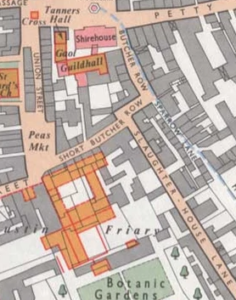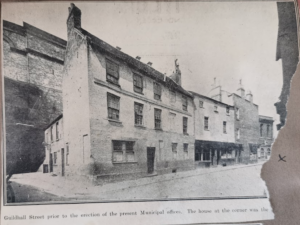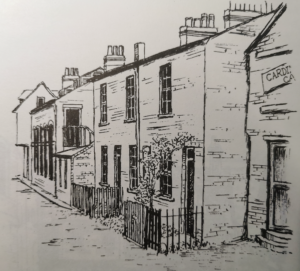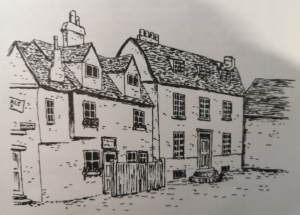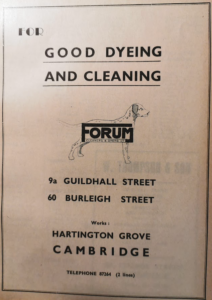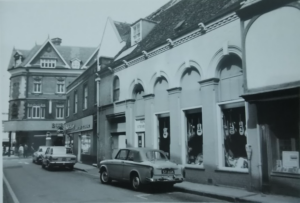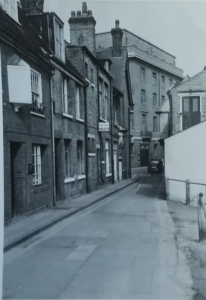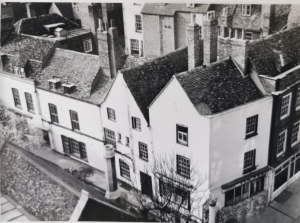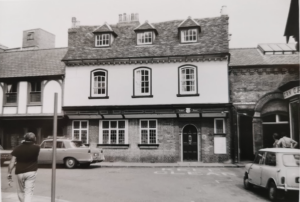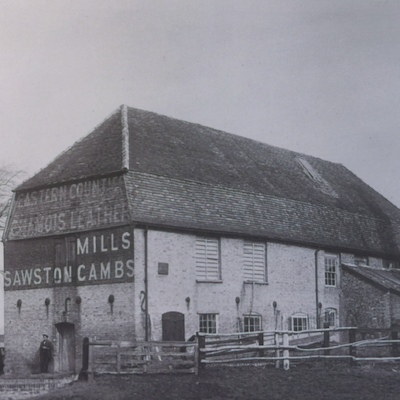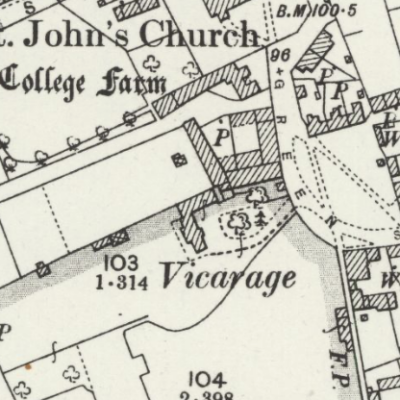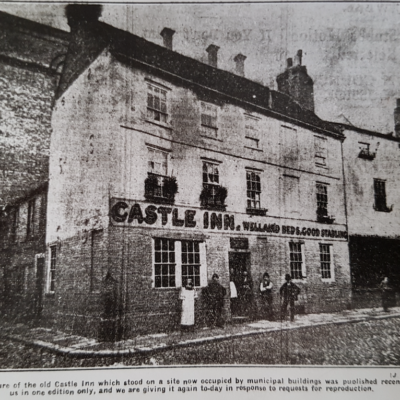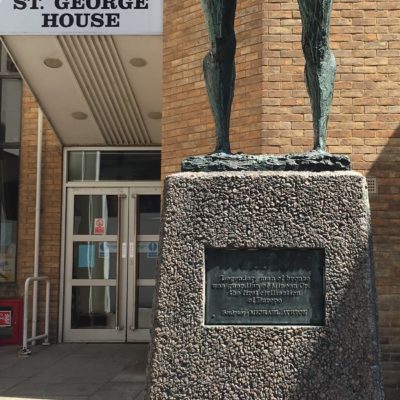Search by topic
- archaeology
- Building of Local Interest
- charity
- church
- crime
- dressmaker
- fire
- Great Eastern Railway
- Listed building
- Mapping Relief
- medieval
- oral history
- poverty
- Public House
- Rattee & Kett
- Religious House
- Roman
- scholar
- school
- Then and Now
- tudor
- women
- work
- world war one
- world war two
Search by text
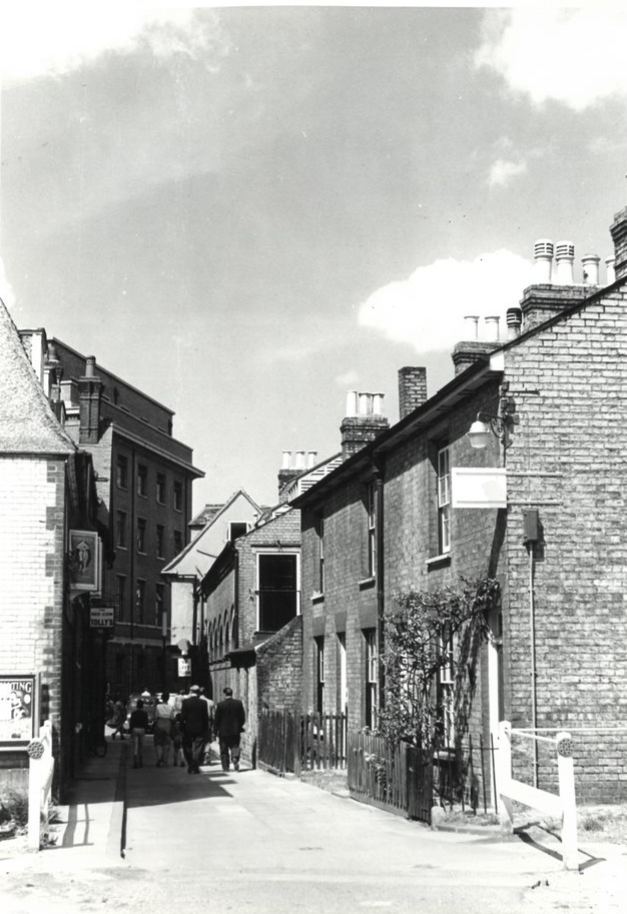 Guildhall Street looking north towards Guildhall circa 1960 (MoC)
Guildhall Street looking north towards Guildhall circa 1960 (MoC)Guildhall Street (Butcher’s Row)(South & East Side)
History of Guildhall Street (East Side)
Guildhall Street was previously known as Butcher’s Row.
1861:
1 Butcher Row:
William Bond, 42, grocer, b Cambridge
Anne, 40
Anne, 14
Henry, 7
Thomas Hallack, brother in law, 45, grocer, b Cambridge
Charles Whichello, 28, grocer’s assistant, b Bourn
Walter Bennett, 26, grocer’s assistant
George Havill, 24, grocer’s assistant
Phebe Howell, 31, domestic servant
Susan Wright, 25, domestic servant
Melia Ridley, visitor, 19, governess.
The Whichello family came from Bourn and are mentioned in William Farrington‘s diary circa 1858.
See Hallack and Bond entries.
2/4/1899 The Red Cow Inn concert hall, Guildhall Street, Cambridge. Special engagement for six nights of Miss Sadie St John, comedienne and dancer; Miss Gracie White, serio and dancer and Mr G. Kent, comedian and mimic. American bowling saloon now open. (Cam.News)
1913:
Harry Swan, Red Cow Inn
H C Webb, corn and seed merchant
GUILDHALL PLACE
GUILDHALL CHAMBERS
Whitehead and Todd, solicitors
Fabb and Tyler Ltd, paper warehouse
6. Sidney Charles Stamp, bioscope operator
9. Francis Lupson
10. A Ransome, Colour-Sergeant, Army Recruiting Officer
11. C H Webb, hotel porter
12. Harry Webb, cabdriver
13. Alfred Marsh, assistant at Guildhall
14. Harry Gets, journeyman butcher
15. George Whatnell, cabinet maker
16. Frank Hewett, painter
17 & 18. stables
19. James Tuck
John Witt
20 & 21. John Tomlin, Cardinal’s Cap
(East side from south end)
22. Wm Maskell, laboratory assistant
23. James R Taylor, horsekeeper
24. –
Fabb and Tyler Ltd, ‘Cambridge Review’ and general printing office
7. Joseph J Newman, billiard rooms
8. William Widdows, Black Swan
9. William Thomas May, The Lamb Inn
Recruiting House for Army and Navy
10 & 11. Morley & Co, wholesale and retail wine and spirit ,erchant
12. A R Nichols, butcher
Here is Petty Cury
4/6/1914: An alarming accident happened in Petty Cury. Outside Mr A.E. Nichol’s shop at the comer of Guildhall Street there are large incandescent globes suspended. One of these globes, which was
illuminated, suddenly collapsed and struck the pavement with an alarming crash. The street was crowded at the time and it was marvellous that no one was hurt. The globe fell at the feet of a bystander who luckily was not injured, though glass was scattered in all directions (Cam.News)
14/7/1924 Cambridge is shortly to lose a rendezvous which has become very popular in the years succeeding the war. I refer to the “Dug-Out” which, with the Black Swan public house next door (in Guildhall Place) has been sold to the University Catholic Association. It is their intention to transform the premises into a centre for Roman Catholic undergraduates
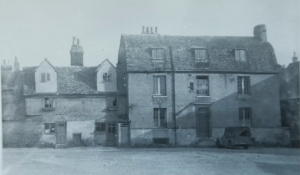
The Cardinal’s Cap in Guildhall Place seen from the yard of the Lion Hotel. Inn was demolished in 1927. (MoC159/57)
4/9/1930: A Cambridge women told the court she had locked the door of her home at no.5 Guildhall Place but left the front window unfastened to allow her son to get in during the night. She was awakened by her estranged common-law husband who had got in and was flourishing a revolver. He said it was a dummy revolver loaded with blank cartridges and explained they had lived together for 14 years until she took up with a new man. (Cam.News)
19/8/1932 John Austin Fabb started in business as a printer, moving to Guildhall Street in 1881 and Corn Exchange Street in 1920. He printed the Cambridge Review from its inception in 1879 and conceived the idea of a list of Resident Members of the University in 1 890. During the war he compiled seven editions of the list of Cambridge University men on active service. He was a prominent Freemason and founded the York Street Sick Club. (Cam.News)
On the far left is Fisher House, overhanging the pavement. Next to it is the arcaded ‘Dugout’, a First World War cafe. In 1920 it was the proposed site for a new cinema, as the Lion Yard became more and more firmly the social centre of the town. Instead it became ‘the Dugout Assembly Rooms.’ The terrace of three small houses in the middle of the picture, with small front and back gardens, was built about 1800. … On the right is the end of the Cardinal’s Cap. (The Lion Yard, Cambridge History Agency 1974)
This was the yard of the Cardinal’s Cap Inn and had two houses. On the left is the inn. presumably founded for the Reformation. The house to the right was lived in by a don until WWII. The inn survived until 1927; the other houses were demolished in the early 1970s.
1962
East Side
1. Abbott’s Cambridge Tourist Centre
1. Burnett Bureau Employment Centre
University Roman Catholic Chaplaincy [the Black Swan pub was converted to form the chaplaincy by the architect Jack Arnold Crush]
8. Cambridge University Fisher Society
9. Robinson and Gilbert Ltd estate developers
10 & 11. Morley and Co wine merchants
1970
East Side
1 Cambridge Central Aid
1 Cambridge Advice bureau
1 Moden Craft Gift Shop
University Roman Catholic Chaplaincy
8. Cambridge University Fisher Society
10. Ken Stevens Musical Instruments
Contribute
Do you have any information about the people or places in this article? If so, then please let us know using the Contact page or by emailing capturingcambridge@
License
This work is licensed under CC BY-NC-SA 4.0





